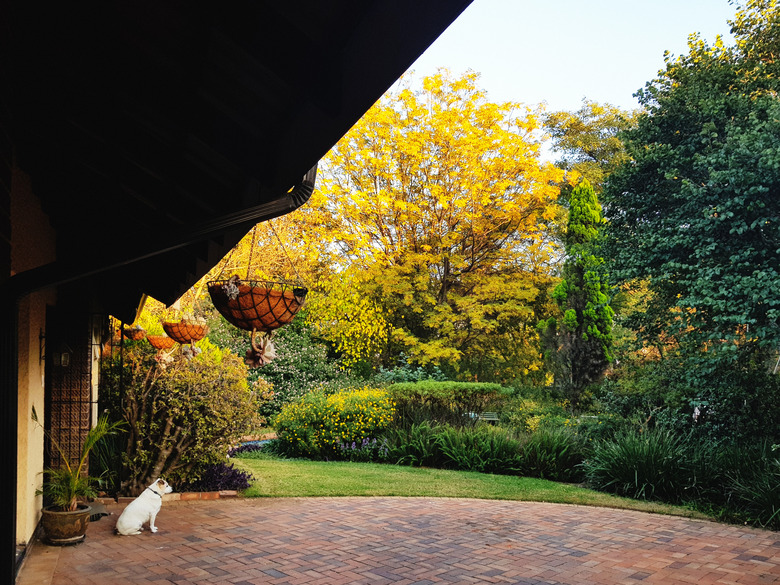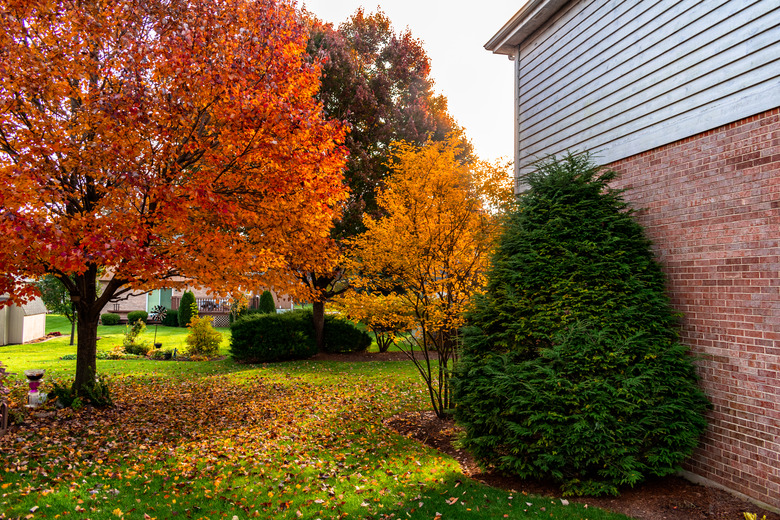A Homeowner's Guide To Fall Landscaping Care
We may receive a commission on purchases made from links.
In late summer as the growing season nears its end, it's time to think about fall landscaping tasks. Many tasks help keep plants healthy, and others, particularly those in the front yard, also help maintain a home's curb appeal. As you prepare your landscape during the fall season for the upcoming winter months, you may be accustomed to taking rake in hand and cleaning up fallen leaves, but there's more to fall landscaping DIY projects than simply raking leaves.
Since each yard has different features, you can make a custom checklist that's populated with the tasks that fit your landscape's specific maintenance needs. Your yard, for example, may host lots of perennial flowers, while your next-door neighbor's approach to landscape design includes only trees and shrubs. So, as you make your fall landscape maintenance list, customize it by walking around your yard and taking note of its different features or different sections that may need individualized attention.
A General Fall Landscaping Checklist
A General Fall Landscaping Checklist
Some items on your list may not apply to other yards in your neighborhood — even that of the neighbor right next door to you — while other items are general tasks that apply to many landscapes. Fall is the ideal time to perform these tasks, and the cooler autumn temperatures after a hot summer make working outside a pleasure.
Removing fallen leaves. Planting deciduous shade trees for fall color brilliantly colors the landscape when many perennial flowers are well past their blooming season. The trade-off for this fall color is having to clean up the dropped leaves. The traditional leaf rake takes a fair amount of elbow grease, especially in large landscapes, and a leaf blower is the tool of choice for many homeowners, but there's another option that benefits your lawn: mulch mowing. Using a conventional lawn mower, you simply mow over the fall leaves as they drop from trees to grind them up and leave them in place as a mulch cover for your turfgrass. You'll need to mow each time the falling leaves form a thin layer on top of the grass.
Mulching. Applying a 2- to 3-inch layer of mulch will help insulate the roots of plants, conserve moisture and give a finished look to borders, islands and garden beds. Different types of mulch include compost, shredded bark and pine straw. When you mulch around trees and shrubs, pull the mulch away from trunks and stems so it won't hold moisture against the plants, which can lead to rot or other fungal infections.
Pruning. Typically, you won't have to prune shrubs or trees in fall since most of them respond best to spring or winter pruning depending on the species. You can go ahead and remove any broken, diseased or dead branches in fall. Sanitize your pruning tools by wiping them with 70 percent ethanol or isopropyl alcohol to prevent the spread of disease. You may also need to cut back some perennials by removing the dead foliage. Wait until the following year to prune certain shrubs that form flower buds on old growth, such as bigleaf hydrangea (Hydrangea macrophylla), a perennial in U.S. Department of Agriculture zones 5 through 11. A late-season fall pruning will likely remove the flower buds that are already forming for next year.
Fertilizing. Fall is not the ideal time to fertilize plants except for some types of turfgrass that benefit from adding nitrogen fertilizer this time of year. Withhold fertilizer for landscape plants when their growth slows as the weather turns cooler in late summer. If you fertilize late in the season, plants may produce tender, new growth that may be damaged by fall frosts.
Bulbs and Other Perennial Flowers
Bulbs and Other Perennial Flowers
Fall is the ideal time to plant spring-flowering bulbs and to divide spring- and summer-flowering perennials in your flower beds. You won't need to divide perennials every year, but if you notice that some of your plants aren't producing as many flowers, it may be time to divide them.
An example is the daylily (Hemerocallis spp., USDA zones 3 through 9), which grows from tuberous root systems that form clumps. When these clumps become overgrown, flowering may decline, but you can jump start their bloom potential by simply dividing your daylilies in fall and replanting the divisions.
Plant spring-blooming bulbs before the first frost, well before the ground freezes. Choose a site that has good drainage because soggy soil may rot the bulbs. As a rule of thumb, bulbs should be planted to a depth that's two-and-a-half to three times the height of the bulb. For example, a bulb with a height of 2 inches should be planted 5 to 6 inches deep.
Vegetable Garden Fall Maintenance
Vegetable Garden Fall Maintenance
After you've harvested cool-season vegetables from the fall garden, it's time to prepare the vegetable garden for next year. Practicing good sanitation when you clean up the vegetable garden in fall is critical for its success the following year. Insects and diseases can overwinter in any debris that's left in a vegetable garden and can infect the following season's plants. Remove all vegetation, including spent vegetable plants, rotten vegetables, leaf debris and weeds.
After you've cleaned the vegetable garden, add organic matter to enrich the soil for next season's crop, such as compost, grass clippings, leaves and well-aged manure. Spread the organic matter on top of your vegetable garden or work it into the garden to improve the soil structure. Organic matter requires time to incorporate itself into the soil, which is why you apply it in fall. If part of your vegetable garden is planted in perennial herbs, apply a 2- to 3-inch layer of mulch around the plants.
Fall Lawn Care
Fall Lawn Care
Tailor your fall lawn care in part around the type of turfgrass you have. If you have a warm-season grass, for example, hold off on fertilizing it this late in the year. After summer's heat has a tendency to turn some grasses brown, you may notice that your grass looks greener in the cool temperatures of autumn. If you live in a snowy climate, set your lawn mower blades for mowing the grass shorter — about 1 1/2 to 2 inches — so that by the time it snows, the shorter grass will not become matted underneath the snow.
Fall is also a good time for aerating your lawn, particularly if you've noticed that the soil has become compacted, it doesn't drain well or you have patchy grass in your yard. Use a core aerator, which you can rent from a garden center, to remove plugs of soil instead of a spike or tine aerator, which can actually compact the soil more.
Hardscaping Fall Maintenance Tips
Hardscaping Fall Maintenance Tips
It's easy to overlook an important part of your overall landscape design when compiling your fall landscaping checklist: the hardscapes that complement your home. Even if you don't remove leaves from your turfgrass, flower beds or vegetable garden, consider removing them from the hardscapes, including your sidewalk, driveway and patio. Not only can fallen leaves stain these hard surfaces but they can also create a slip-and-fall hazard when they're wet.
If you have a walkway made of pavers, be aware that the joints between each paver stone may become uneven or eroded because of freeze-and-thaw cycles during winter. If the joint material becomes degraded enough, the pavers may shift or move underfoot when you walk on them. To ensure firm footing, check the joint material to see if it needs replacing. This may only require filling the joints with sand and using a sand joint stabilizer.
References
- Kansas State Research and Extension: Mulch Mowing Fall Leaves
- University of Florida IFAS Gardening Solutions: Disinfecting Your Garden Tools
- Missouri Botanical Garden: Hydrangea Macrophylla
- University of Georgia Extension: It's Late, But Fall Is Here; Time to Tackle Fall Lawn Chores
- PennState Extension: Plant Bulbs in the Fall for a Spring Celebration
- Utah State University Extension: Ask an Expert – Four Areas of Focus for Fall Yard Cleanup
- Missouri Botanical Garden: Hemerocallis Fulva
- County Materials Corporation: Fall Maintenance Tips for Hardscape

